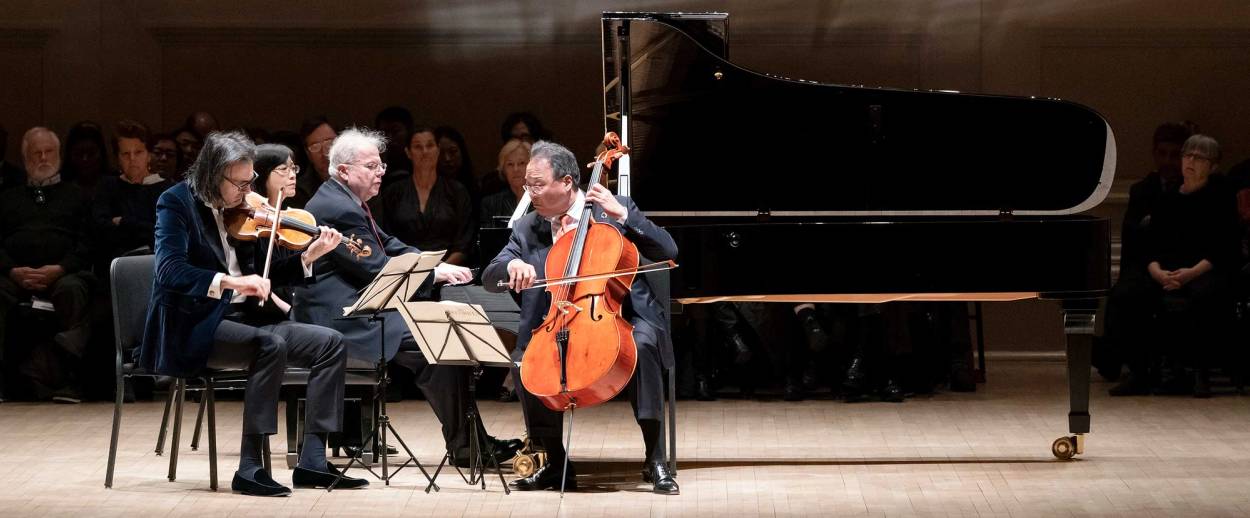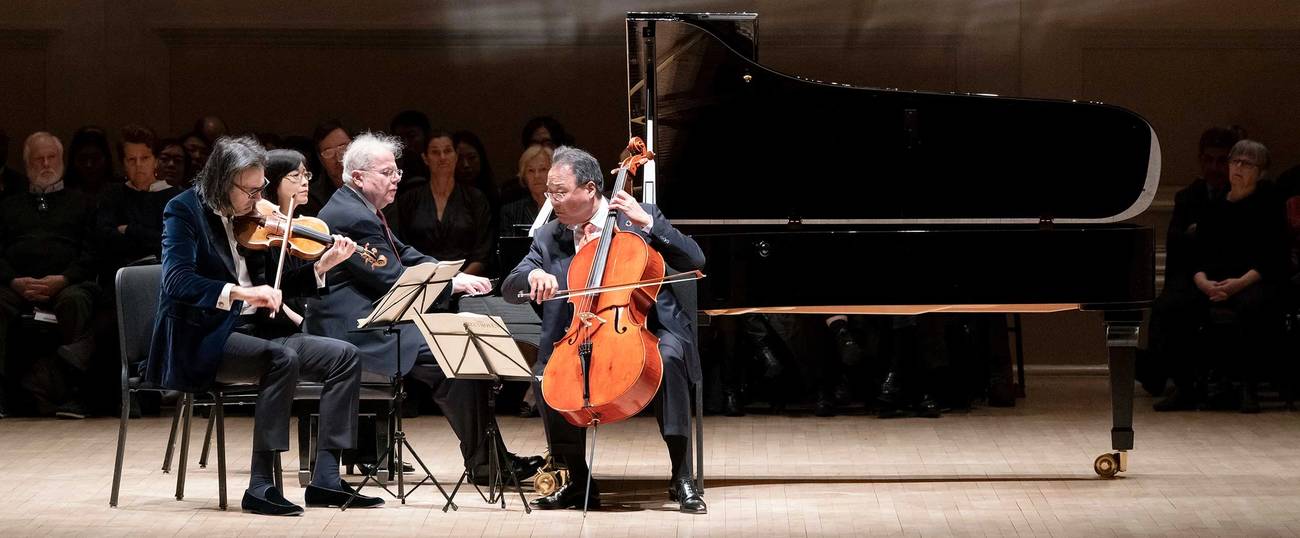The Jewish Beethoven
Emanuel Ax, Yo-Yo Ma, and Leonidas Kavakos celebrate a double anniversary at Carnegie Hall




Not often does the New York concert audience feel history being made as well as recreated. Pianist Emanuel Ax, cellist Yo-Yo Ma, and violinist Leonidas Kavakos celebrated a double anniversary at Carnegie Hall on March 6—the 250th year of Beethoven’s birth as well as the 100th birthday of the late violinist Isaac Stern—with performances of epoch-making musicianship. Ma is only a year short of the 50th anniversary of his 1971 Carnegie Hall debut at age 16; Ax debuted in New York in 1974, and the audience erupted in blissful applause when they stepped on stage. The younger Kavakos is a worthy addition to their ranks.
The great composers require memory. Popular music dwells in the moment, but classical music employs the past to create a sense of the future. An educated ear is required to hold in memory the musical events of a long movement in which the composer traverses an extended territory to reach the musical goal. Just as important is the receptivity of the audience to the musical past. Carnegie Hall was at capacity despite a health emergency that has left the Metropolitan Opera half empty during the past fortnight, filled with concertgoers who had heard these performers for decades, and before them the great Isaac Stern, whose organizational genius saved the great venue from a planned demolition in 1960. They came to hear old friends in intimate musical dialogue. Through this dialogue Beethoven could be felt as a living presence.
Ax observes in a program note that “Beethoven chose chamber music as his calling card to the great world.” We tend to forget that most music before the age of recording was performed in homes, and that chamber music formed the great majority of what people heard. The program Friday was an appropriate start to a year of Beethoven celebrations.
Asian and European tourists comprise a high proportion of New York’s audience for opera and symphony, but the audience for chamber music is overwhelmingly local and disproportionately Jewish. That is why Ax, Ma, and Kavakos filled Carnegie Hall while the interruption of overseas tourism has emptied the Metropolitan Opera. That is as it should be: Some of Beethoven’s works, especially from his so-called middle period, have a deeply Jewish sensibility, which arises from the creation of time. In the pagan world, and in popular music generally, time is a given, the mere measure of systole and diastole, the rotation of the planet, the turn of the seasons. It was inconceivable to Aristotle that such a world could be anything but eternal and unchanging. As Maimonides argued, the biblical statement that God created the world implies that God created time itself.
Starting with his Third (“Eroica”) Symphony in 1803, Beethoven composed music with a temporal expansiveness that no one had heard before. His violin sonata in A minor, Op. 28, the opening piece on the program, was composed in 1800. In outer form it looks backward, although one can sense Beethoven’s restless spirit struggling to emerge, like the figure in an unfinished statue of Michelangelo. The third cello sonata in A major, Op. 69 (1807), and the “Archduke” trio in B-flat major, Op. 97 (1810), offer another dimension of time transformation. They look forward to the Op. 110 and Op. 111 piano sonatas with their concluding elongation of time.
The most obvious characteristic of Beethoven’s new temporality is length. No one had ever heard a symphony as long as the Eroica, nor a piano trio as long as the Archduke. The new plasticity of time allowed Beethoven to prolong musical ideas and create musical surprises on a hitherto unknown scale.
Before Beethoven, the duo sonata and the piano trio subordinated stringed instruments to the keyboard. The strings served as enhancements to the limited sonority of the early pianoforte. The A-major cello sonata, one of the composer’s best known and most beloved chamber works, offers instead a dialogue of equals. The cello offers its unrushed opening phrase, which points to a dominant that will not be resolved, but rather picked up by the piano and left hanging in a long ritardando. The unresolved opening theme acts as long upbeat to the whole of the first movement, whose conversational expansiveness is like nothing in the whole of the earlier repertoire. Ma and Ax have played it together for decades; a 1985 performance in Tokyo for example can be found here. But they have never played it better than they did last week in New York, when the work sounded younger and more spontaneous than in their earlier versions. They know each other well enough to finish each other’s sentences, which is just what Beethoven requires. They echoed each other’s phrases uncannily even in the most challenging passage work. There are thousands of young musicians who can play all the notes, but reciprocal phrasing of this quality requires a quality of concentration that is given only to the great.
The Archduke begins with deceptive geniality, with what seems like an easygoing theme in the piano. But Beethoven alerts us that the phrase will not conclude in four-square fashion, by marking a dynamic stress on the B-flat at the second quarter-note of measure 5. The sforzando on the weak beat tells the listener that the phrase will keep driving forward. Most performers ignore Beethoven’s seemingly counterintuitive dynamic instruction and trudge on as if the theme were a march. I reviewed numerous performances of the Archduke by prominent musicians, and very few (e.g., the Casals-Horszowski-Vegh version) follow Beethoven’s instructions. Ax and his colleagues got it exactly right, and whacked the key sforzando with gusto. When the violin and cello take the theme from the piano, it expands into Beethoven’s open-ended time.
Like the opening of the Eroica Symphony or the A-major cello concerto, the beginning of the Archduke creates freedom in time. A particularly poignant example of this is the transition from the development section of the first movement to the recapitulation. In major-key classical compositions the development section almost always concludes on the dominant, setting up a cadence to the tonic in which the original theme resumes. Beethoven had something far more devious in mind. A chromatic descent in the piano leads to a prolonged trill on C-flat/B-flat in the piano’s upper register, with simultaneous half-step trills in the violin and cello. The expected dominant is present but clouded by chromaticism, for the half-step trills point in several tonal directions. The ear enharmonically interprets piano’s C-flat as a possible B-natural. Time is suspended by the trills as the ear searches for direction.
Of course, the C-flat resolves downward onto the tonic B-flat. When the reprise of the original theme appears in B-flat, the effect is like sun breaking through clouds. That sort of device is found in Beethoven’s later piano sonatas, from the Op. 106 (“The Hammerklavier”) to his final sonata Op. 111; to my knowledge, it first appears at the cited point in the Archduke. That was the only point in the score where I felt that Ax, Ma, and Kavakos missed their cue, tromping through the passage rather than lingering on Beethoven’s almost-miraculous suspension of time. For reference, listen to the Casals version at 10:33 minutes. That was a minor lapse in a magnificent rendering.
The scherzo of the Archduke begins with a seemingly innocuous antecedent-consequent phrase. A rising scale in the cello is answered by a descending line that pauses on the dominant. The two strings take this antecedent back to tonic before the theme is picked up by the piano. Momentarily, though, Beethoven let us know that something quite different is at work; the merry theme turns into a sorcerer’s apprentice that meanders without reaching a conclusion. On a grander scale Beethoven used the same idea in the scherzo of his Ninth Symphony a dozen years later.
For many Jews who lost (or never had) religious faith, Beethoven offers a quasi-religious experience. It is easy to see why. The fundamental imperative of Judaism is partnership with God in creation. God’s first creative act was the creation of time itself, and the most characteristic Jewish act is the creation of sacred time through Shabbat. Rabbi Joseph Dov Soloveitchik often cited the rabbinic dictum that when a Jew recites the Shabbat evening Vayechulu blessing, “And the heavens and the earth were completed …,” it is as if he created the world along with God. Imitatio Dei, emulation of God, begins with emulating God’s creation of time. Rav Soloveitchik loved classical music, and—according to reports of some his students—ruled that Orthodox Jews could listen to “sublime music” even during the three weeks of mourning before the 9th of Av, the anniversary of the destruction of the Temple, when the music of merry-making is prohibited.
Freedom is creativity, and Judaism offers mortal man a creative partnership with God whose point of departure is the creation of sacred time. It is not arbitrary freedom, but a freedom rooted in divine law. Arbitrary freedom is no freedom at all, but slavery to happenstance. There is a parallel here to Beethoven’s new musical freedom. He bends but never breaks the logic of tonality. His boldest chromaticism keeps the tonal goal in view.
The mainly Jewish audience at Carnegie Hall came to hear Beethoven as a quasi-religious exercise. As a lifelong music lover and a ba’al teshuvah in middle age, I can attest that there is a difference. Music can be a religious experience, but Judaism offers a life. The great composers can give us an intimation of freedom whereas Jewish life sustains the real thing. Music isn’t a substitute for religion, but it does evoke the divine spark that enables mortal man to become the partner of the Creator.
***
Like this article? Sign up for our Daily Digest to get Tablet magazine’s new content in your inbox each morning.
David P. Goldman, Tablet Magazine’s classical music critic, is the Spengler columnist for Asia Times Online, Washington Fellow of the Claremont Institute, and the author of How Civilizations Die (and Why Islam Is Dying, Too) and the new book You Will Be Assimilated: China’s Plan to Sino-Form the World.